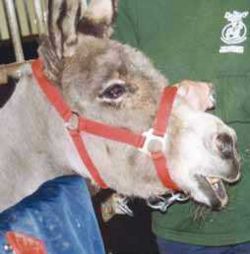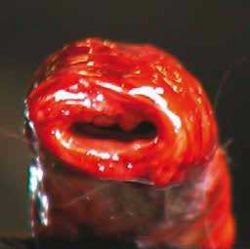Difference between revisions of "Tracheal Collapse - Donkey"
m (Text replace - '{{review}}' to '') |
m (Text replace - '{{review}}' to '') |
(No difference)
| |
Latest revision as of 12:41, 18 March 2010


Tracheal disease is uncommon, but age-related degeneration of the tracheal rings and cartilage may present as tracheal collapse in older animals. As the cartilage becomes brittle and less elastic, dorso-ventral collapse occurs. The donkey may present with a chronic honking cough, or sudden acute respiratory distress and severe inspiratory and expiratory dyspnoea; vibrations may be felt over the ventral cervical trachea. On X-ray, dramatic narrowing of the trachea is evident. The site of the collapse is often at the thoracic inlet and has also been found at the tracheal bifurcation and mid-trachea.
Pre-existing lower respiratory tract disease leads to increased airway pressure changes and exacerbates tracheal collapse. Treatment of severe acute cases is generally not possible, as a tracheostomy may not bypass distal lesions and will increase mucosal swelling and oedema. Euthanasia is advisable. In mild or chronic cases, airways should be kept as healthy as possible by clean air management with the use of bronchodilators and anti-inflammatories as required. 'Dexamethasone and frusemide may limit mucosal swelling and help reduce co-existing pulmonary oedema.
References
- Thiemann, A. (2008) Respiratory problems In Svendsen, E.D., Duncan, J. and Hadrill, D. (2008) The Professional Handbook of the Donkey, 4th edition, Whittet Books, Chapter 7
|
|
This section was sponsored and content provided by THE DONKEY SANCTUARY |
|---|